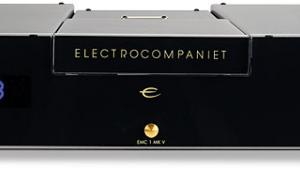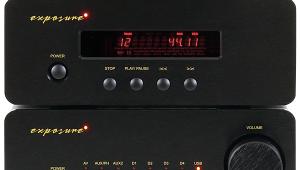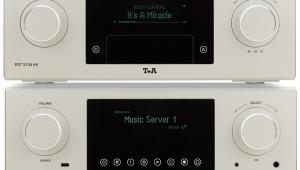Oracle Cd2500 Mkii (£10,000)
One of my less endearing traits, of which I have several according to my long-suffering wife, is that I’m inclined to show off now and again. So when chatting to an acquaintance on the telephone recently I simply couldn’t resist dropping into the conversation that my living room was currently ‘cluttered’ by two outrageously expensive CD players: the £8000 Wadia 381i [see HFN July ’09] and the new £10,000 Oracle CD2500 MkII.
Moreover I was going to have to spend several days listening to music on them, using the familiar Wadia as a point of reference, and subsequently write a critique on Oracle’s new baby. Such is a reviewer’s lot. While I might have preferred to do something else – meet up with friend at the pub, perhaps? – I simply had to listen to this gorgeously crafted CD player costing £10,000. Whether I wanted to or not. If I was looking for sympathy I sure didn’t get it, as you might imagine.
IF LOOKS COULD KILL
Redolent of Oracle’s space age looking record players, that had some of us going weak at the knees when we first saw them 30 years ago, the Canadian company’s compact disc spinners are visually striking to say the least. This ’2500 MkII model follows the form of Oracle’s CD2000 CD Transport. At the rear, analogue outputs (both single-ended RCAs and balanced XLRs) replace the ST glass optical and AES/EBU digital outputs which featured on the ’2000 transport, the sole digital output on this player being S/PDIF on a BNC connector.
While calling the CD2500 MkII an integrated player is entirely accurate, it boasts the construction of a three-box player with its disc transport linked via ribbon cable to a separate housing underneath. This contains the control electronics, D-to-A converter and output stages. A remote power supply unit, in a rather plain black box that is not entirely befitting of the main unit’s sculptured magnificence, connects with a 15-pin D-Sub cable.
There’s no question that the ’2500 does look utterly magnificent. The finish of the elaborately machined aluminium parts, coated with polyester lacquer to seal and preserve the appearance, is quite impeccable.
DOING MANUAL LABOUR…
If you’ve never lived with a manual top loading CD player I would advise you consider it carefully before blindly taking the plunge. The thing about compact disc, love it or loathe it, is that unlike vinyl records it is extraordinarily simple to use and there is nothing fragile to get easily damaged. You can entrust friends and family members – even your kids – to play CDs on your beloved hi-fi system, can’t you?
Not so with the Oracle ’2500. For a start, the aluminium top cover, lined on its underside with black felt, needs to be carefully lifted off to reveal the disc mechanism inside. You’ll need somewhere convenient, an adjacent shelf perhaps, to ‘park’ this cover while avoiding contaminating the felt lining. A disc is held in place with a magnetic puck to reduce ‘chatter’, designed with a ‘tacky’ urethane washer attached to its underside to create a slight vacuum with the disc. But as you lift the puck to remove it in order to change a disc, the CD comes with it... for a moment at least, until it suddenly lets go. You need to be prepared for this or else your CD will end up rolling across the floor.
And it’s imperative to keep the puck’s urethane washer scrupulously clean too, so you mustn’t place it face down else contamination will spoil its efficacy. Oracle supplies a bottle of Brilliance cleaner and lint-free cloth with each player for regular cleaning of the puck’s underside washer.
Are you going to let your kids anywhere near this Oracle CD player, then? Er, no, probably not. What about the fabulous Wadia high-end player that’s been residing in my rack for the past few weeks? Do I let my teenager daughter play CDs on that? Yes, why wouldn’t I? She puts a disc in the loading tray, as with any silver disc player she’s ever come across, and presses Play.
There’s a final operational quirk that needs mentioning. No doubt you’ll be aware that when you close the tray on a conventional player the disc spins for a few seconds while the player reads the CD’s table of contents (TOC). Consequently when you settle into your favourite armchair you can either press Play to start listening from the beginning of the disc, or go directly to any desired track in an instant, because the player has already studied the disc’s contents and knows precisely where to go. Again, not so with the ’2500. Each time you load a disc you must first press a ‘reset’ button on the player – or stab the Standby button on the remote controller twice in quick succession – in order to instruct the Oracle to read the new disc’s TOC. Only after this can you press Play. Yes, really.
RITUAL CAMPAIGN
Hey folks, this is all part of the ritual. Call me cynical if you will, but I can’t help suspecting that this has been deliberately designed in to add to the player’s cachet. It’s arcane. And it’s unnecessary. Still, this is not the first slightly quirky manual CD player ever to be designed, nor will it be the last. And is the operational ritual worth it? Well, it takes but an instant to hear that the CD2500 MkII sounds simply sumptuous. It’s got energy and drive in abundance, with plush, textured bass that never fails to convey the drama of large orchestral works or the vigour of stirring rock and pop productions.
Referencing one of the discs auditioned recently on the delightful Wadia 861i, David Sylvian’s haunting ‘River Man’ from Gone To Earth [Virgin CDVDL 1] was terrifying in its intensity. Perhaps a little less ‘airy’ than with the Wadia, the Oracle painted a darker picture of the electronic soundscape. Robert Fripp’s treated guitar and ‘Frippertronics’ appeared less ethereal and more vital to the piece, while the thunderous sampled bass notes crept across the carpet in ominous fashion. Mel Collins’ mournful soprano saxophone sounded like it was just about to burst into tears.
It took little time to determine that the ’2500 is less delicate sounding than the Wadia 381i while being altogether more visceral. You’ll take your choice and pay your money. The Ensemble Modern’s Plays Frank Zappa disc [BMG 59842-2] proved that the Oracle was equally as adept as the aformentioned Wadia at conjuring up images of the musicians performing at the end of my room, treating me to an intimately private concert. Interestingly, with the Oracle it was like observing the players performing in a different space, with a drier acoustic. Instruments concomitantly sounded more sharply focused; the musicians’ performance appeared more commanding of attention.
It took precious little more time to fall in love with the sound of the Oracle. It’s not that it is fabulous at revealing previously unnoticed details in recordings. Rather I would argue that it appeals more to the heart than the head, thanks to the energetic manner in which it describes a musical event, drawing you into the music and compelling you to pay attention.
FORTHRIGHT ENERGY
Listening to Robert Fripp’s distinctive guitar playing on Sylvian’s album had led me to dig out King Crimson’s Starless and Bible Black [E’G, EGCD 12] from way back when. Crikey, it’s a while since I’ve been so gripped by my replay system. The Oracle ’2500 had me lashing the air in unison with Fripp, Wetton, Bruford et al as ‘The Great Deceiver’ let rip at a hundred miles an hour with its multiple layers of thrashing guitars and electric violin.
Later on in the album the plaintive ‘The Night Watch’ saw me playing air guitar with abandon as Fripp’s solo twisted and weaved around the lyrical melody lines. Call me an old hippy if you will, but I don’t mind admitting that the subsequent flight of mellotrons sent a shiver down my spine.
Not that the Oracle always worked its magic. The title track on Paul Weller’s Wild Wood [Go! Discs 828 513-2] was a little too dry, the rather thick and ‘closed-in’ recording quality of this track rendered lighter by the Wadia and sounding better for it. Nevertheless there’s a forthright immediacy to the sound of the ’2500 that rarely fails to set the pulse racing. So feed the Oracle a less stodgy diet and more often than not its energy will grab you by the earlobes and demand that you be impressed. Certainly I was.
Having put them off for the past few weeks I’m due to join a couple of neighbours this weekend in a local hostelry. Doubtless I’ll feel guilty if I don’t drag them back to my listening den afterwards for a quick blast of this beautiful Oracle. ’Cos once the importer has taken it away they’ll only ever have my description of its sound to rely on, along with our photographs. And that’ll never recreate the thrill of having heard it.
VERDICT
Stating the obvious, as with any manual top loader there’s a ritual involved in playing a CD on the Oracle that will not suit everybody. That aside, much like Oracle’s turntables, the CD2500 MkII looks and feels absolutely exquisite. Sound quality is in the top league too, with an opulent, earthy quality that imbues intensity to large orchestral works and really drives rock music at full throttle. Fabulous!
Originally published in the September 2009 issue























































